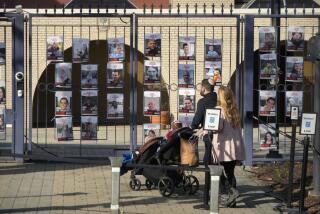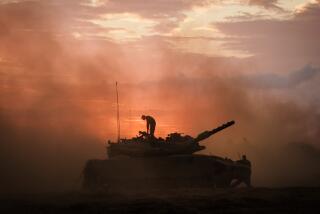U.S. Envoy Tells of Embassy Bombing Ordeal in Kenya
- Share via
NEW YORK — The former U.S. ambassador to Kenya described to a jury Thursday how a procession of survivors--many of them bleeding, praying and singing hymns--reached safety after the bombing of the American Embassy that killed hundreds in that African nation.
It was the most dramatic moment so far at the trial of four followers of Islamic extremist Osama bin Laden who are charged with bombing U.S. embassies in Nairobi, Kenya’s capital, and Dar es Salaam, the capital of Tanzania, killing 224 people in August 1998.
Prosecutors also showed a videotape of bodies and rescuers frantically searching through rubble--leaving some jurors obviously shaken.
Prudence Bushnell, now ambassador to Guatemala and the top American diplomat in Kenya from July 1996 to May 1999, said that on the day of the attack she was attending a meeting with Kenya’s trade minister and six or seven other people at a nearby bank.
She said the conference began at 10 a.m. and four minutes later an explosion occurred, followed by a second huge blast. Some people rushed to a window when they heard the first noise.
“I had just taken a few steps before this huge explosion happened,” Bushnell said. When she regained consciousness, she was sitting with her hands over her head and the ceiling was falling down, she said.
“I will never forget the rattling of a teacup--just kept rattling. I thought to myself that the building was going to collapse, that I was going to tumble down all those stories and that I was going to die,” Bushnell told the jury.
She and a colleague climbed over a door and found someone’s shoe and a great deal of blood. They began to descend “endless stairs” and were joined by people from other floors who sometimes shouted welcome, she said.
“You could hear some people who were praying. Some other people were singing hymns,” Bushnell said. “Down we went. . . . This huge procession of people who were bleeding all over one another.
“I could feel the person behind me bleeding on my hair and down my back,” she said. “. . . At one point a woman collapsed. I am not sure if she died.”
Finally, the procession reached the street, which was covered with glass. The back of the bank was completely ripped off--”utter destruction.”
“I saw the charred remains of what was once a human being,” Bushnell said. “It was this kind of scene from war.”
Bushnell said that despite suffering cuts and bruises, she decided to go to a hotel to work instead of to the hospital emergency room, where the wait would be too long. Eventually, her lip was sutured and her hands were bandaged.
Prosecutors asked her to describe for the jury some photographs of the destruction.
“If you look at the embassy and you look to the left of the embassy, you can see some white rubble,” she said. “That was once a seven-story building . . . filled with people.”
Bushnell said that while the embassy, which was built to withstand earthquakes, looked “pretty good from the outside, it was utter devastation on the inside and in the back.”
Interior photos showed blue sky where a wall once stood and offices that were destroyed. A red, white and blue notebook rested on the floor of one office. File cabinets were ripped open and rubble littered the floors. In still another part of the embassy, the massive blast had ripped a hole in the wall.
More to Read
Sign up for Essential California
The most important California stories and recommendations in your inbox every morning.
You may occasionally receive promotional content from the Los Angeles Times.













